This post may contain affiliate links. See my privacy policy for details.
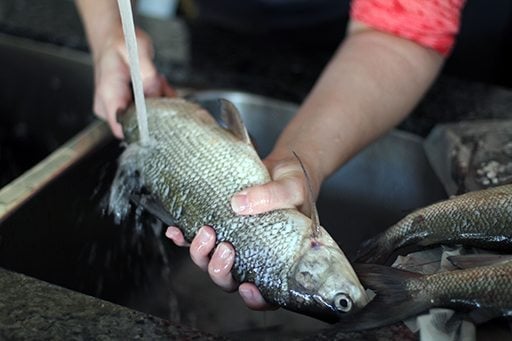
Before we go any further, let’s get one thing out of the way.
Whitefish are better fresh, nothing will compare to it and frozen is not as good.
Now that we have the purist view dealt with, let’s move on to the real life scenario of how to freeze your whitefish for some good eating later on. Not all of us are going to be able to eat all of our catch right away and indeed, some of us wanted a little stash in our freezers to work with when we have time for the recipes that are bouncing around our heads for the whitefish we caught.
First things first. Check your local regulations for your province or state wide maximum possession limit. This is completely different from your daily limit. For my fellow Albertan’s, you can find our regulations here. The province wide maximum limit for lake whitefish and Cisco (Tullibee) is ten fish in combined total.
Please note that this includes all fish you have at home. Smoked fish, canned fish, pickled, dried and frozen are all included in this amount! Because I am a curious person and wouldn’t want to misinform anyone via my website and writing, I called Fish & Wildlife myself to have a great chat about possession limits. It’s very easy to assume that because Grandma had a stash of canned fish at her place that processed/cooked fish doesn’t count. It does. Remember to label all your fish with the date, how many fish are in the package and what they are.
We caught our limit this past Easter weekend- what a way to end the ice fishing season!- which meant nine fish between three adults.
Nine fish to clean, prep and freeze.
Thank goodness my sister was along to help me! Now if you are squeamish or eating lunch, perhaps you don’t want to read a post about cleaning and gutting fish. Why not go and read about the other side of ice fishing? Try my post Ice Fishing With Kids Can Be Like Poking Yourself in the Eye with a Treble Hook or Burbot, Perch & Walleye, Oh My!
Now that I’ve warned you, time to move on to the prep!
From the research I have done on the internet – and the opinions vary greatly- leaving whitefish skin on helps to prevent mushy fish when you defrost it. Removing the scales is the first step.
I use my thumb. Lake whitefish scales are so easy to remove, especially when you are processing them fresh from the lake. Simply put your stopper in the drain to catch scales, run the fish under cold water and simply pop all the scales off with your thumb. The water is keeping them cool and it’s continuously cleaning them off.
I did all nine this way and they turned out beautifully.
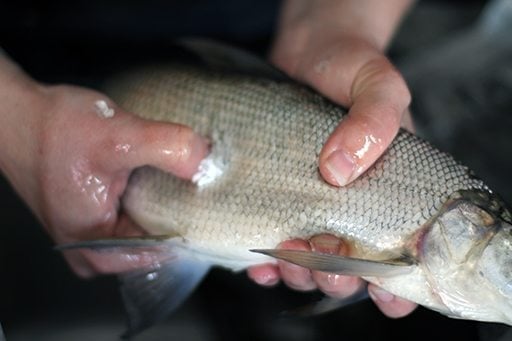
Hope you don’t mind getting messy! However this method means no scales popping off everywhere, all the scales were in the sink or on my hands, which is preferable to all over my kitchen! When you have to clean fish inside, you gotta do what you gotta do!

The second step is to gut and gill the fish. We are prepping our whitefish to be frozen whole, another trick that apparently will help the flesh stay intact and not become mushy when it’s time to defrost.
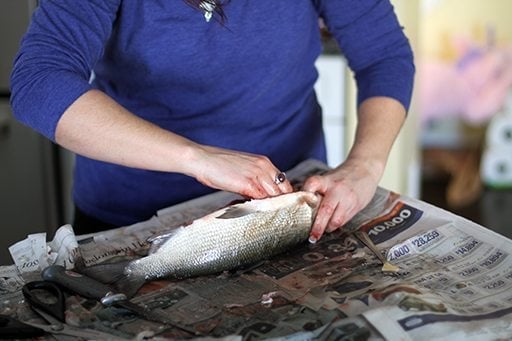
A good fishergirl always checks what the fish have been eating when you gut them.

Sisters.

Dorky, dorky fisher sisters.
Ok, well perhaps I’m the only dork in this picture.

When you have scaled, gutted,gilled and cleaned the whitefish inside thoroughly, it’s time to use a FoodSaver to vacuum seal them up. Remember your food safety, clean those fish! The inside should be sparkling clean before you are sealing them up to freeze!
As sparkling as the inside of a fish gets, I guess. Mine were pink and beauteous to behold by the time we were done!
I have been coveting my sister’s FoodSaver for a couple of years now and was so happy when I was contacted about reviewing one this winter! There is nothing better as a writer than being asked to review a product that you have wanted for a long time. I am so excited to use mine to preserve as much as possible from my garden this year. I foresee blanched beans galore that are vacuum sealed in my freezer this fall to last us the winter!
However, when I received the FoodSaver I knew right away the first thing it was going to be used for was fish from ice fishing this winter.
Using your FoodSaver create the bags that the fish are going to be sealed in. My son adores using the FoodSaver and helped with the entire process. The process of sealing that is, he was pretty scarce when the messy cleaning fish bit was going on!
No matter what I read, the resounding agreement is that if you have to freeze your whitefish, vacuum sealed is the way to go. The old way of freezing them in water has the fillets absorbing too much liquid and becoming watery/mushy as well as too much water can change the taste of the fillets.
We made sure the fish were washed out and NOT dried to ensure that there was a little extra moisture in the packages.

Little hands helping Auntie out.

Once you have made the bag, place your fish in it. We did a headless fish and two fillets which worked out beautifully, sealed up gorgeous. When sealing them, remember to press the fillets gently together to get the air out of the cavity as well, getting a better seal.
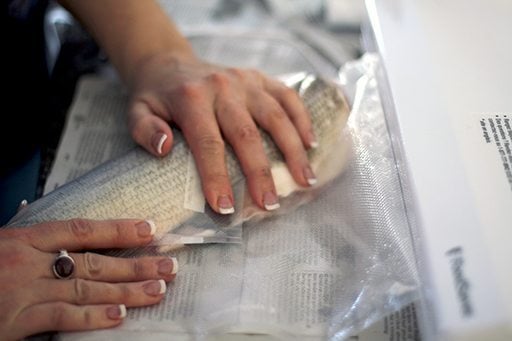
The rest were processed heads on. The reason I did this – other than the rumor that it’s going to help preserve the fillets- is that when you freeze a fish whole you have all of the cooking options open to you once you defrost it to cook it. You can leave the head on, remove it, cut fillets out, whatever you want you can do. When you are storing them you have no idea of what recipes you will be using in the future, so leaving them as intact as possible is a good idea.
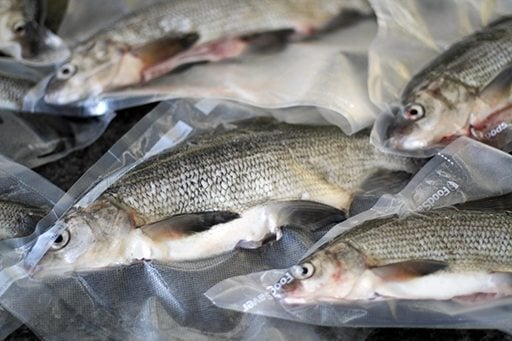
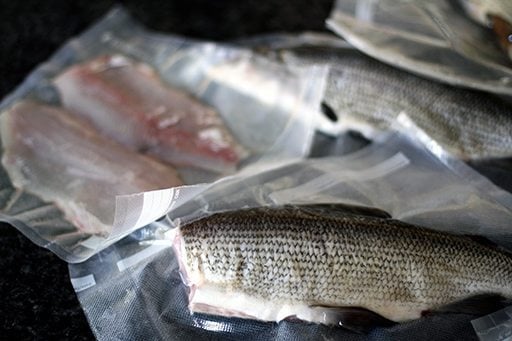
Just gorgeous!
Now, I really won’t be keeping these very long in the freezer because the quality will deteriorate, the vacuum sealing just helps delay it.
A simple trick to help prevent mushy fillets is to defrost them in the refrigerator with a hole poked in the bag to let air in. Defrosting when the bag is still vacuum sealed apparently seems to aid the mushy process.
So, how does everyone else process their whitefish? What are the best methods you have found so far? Any tips and tricks you would like to add to the fray?
Love,
The Can’t Wait to Start Cooking Those Whitefish Magpie











entry mats says
I have used my Tilia foodsaver for just about every species of fish and
game and here’s what I found. Dry the fillets off on towels until dry,
or pre-freeze fillets before sealing or place a small strip of paper
towel ahead of the fillets but behind the seal bar in order to soak up
any stray juices. Seal meat in the center of the bag for optimal
sealing. I never had any luck with species like salmon, trout, shark,
lakers, yelloweye snapper or other “fatty” meat fish. It seems the fat
deteriarates in the freezer, (Fat dosen’t freeze) and these fish turn
“fishy” after a couple months. In otherwords the table quality takes a
nose dive after a couple months. Pike, perch, whitefish, and other
white meat fillets are fine freezer sealed providing you remove the
mudline or fat line on the skin side of the fillet. I had pretty good
luck with freezing these fish with the skin on because the skin helps
protect the fillet, but my wife would rather have the fillet skinned
out.
ViBenner says
The step by step was awesome! I’m with Allan, gotta admit I’m intimidated by the whole process. You girls make it look so easy though!
Beckie Swanson says
Awesome! Again, so glad to see two girls getting knee…er…ankle deep in fish guts! Any summertime fishing coming your way? I can’t wait!
allantaylor says
Not going to lie. I’m pretty intimidated by fish! Looking forward to tackling that fear.
thekitchenmagpie says
_u*********@li******.com
" profile_url="https://www.livefyre.com/profile/11863928/" ns="true">allantaylor Which part? The cleaning or the catching? I guess I am so used to fish guts I don’t bat an eye haha. Have you been out much?
Beckie Swanson says
_u*********@li******.com
" profile_url="https://www.livefyre.com/profile/11863928/" ns="true">allantaylor Allan, it’s easier than you think….I swear! Altho it’s been years since I’ve gone..it’s like falling off a bike, right?